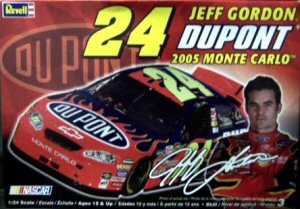
Revell 1/24 Jeff Gordon DuPont 2005 Monte Carlo Kit First Look
By Jeff Conrad
| Date of Review | February 2006 | Manufacturer | Revell |
|---|---|---|---|
| Subject | Jeff Gordon DuPont 2005 Monte Carlo | Scale | 1/24 |
| Kit Number | 2897 | Primary Media | Styrene,,Soft Vinyl |
| Pros | Good detail, excellent engraving, driver figure | Cons | Outdated dash, lack of some decals |
| Skill Level | Intermediate | MSRP (USD) | $15.25 |
First Look
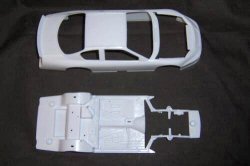 |
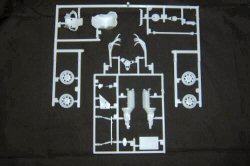 |
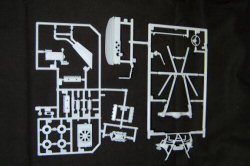 |
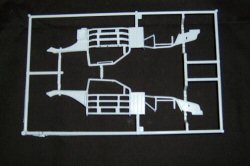 |
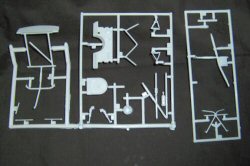 |
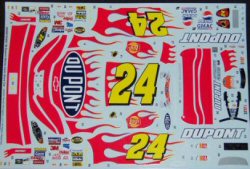 |
Jeff Gordon's first career Winston Cup start was on November 15, 2002 at Atlanta Motor Speedway – which, coincidentally, was Richard Petty's final Winston Cup event. Gordon didn’t win that race, but it wasn’t long before he did win – just 3 months later he won one of the 125 mile qualifiers at Daytona in 1993 (the first rookie in 30 years to accomplish that feat.) His first points win came in 1994 at the Coca-Cola 600 in Charlotte, and hasn’t looked back since. To date Gordon has 73 wins, 269 top ten finishes, 54 poles and has won the NASCAR Championship 4 times – only 2 other drivers have won more NASCAR championships than Gordon - Richard Petty and Dale Earnhart, both with 7 trophies.
In 1995 Chevy introduced their Monte Carlo for NASCAR competition after a 7 year hiatus. This kit is a 2005 version of Jeff Gordon’s DuPont Monte Carlo NASCAR Nextel Cup ride. The body closely represents the currently approved NASCAR Monte Carlo body, while the chassis is same as has been issued since 2000. This kit also includes a 4 piece driver figure. It’s well molded with poseable arms and full face helmet. Some mold lines will need to be cleaned up before painting. The 7 step instructions are well illustrated and nicely organized. As usual for Revell, the kit parts exhibit good, clean molding and nice crisp engraving.
Engine
Assembly starts with the 16 piece engine. This piece represents the SB2 stock car engine, the current Chevy technology in NASCAR. Fine engraving, especially on the transmission, bell housing, and oil pan. Nice looking pulleys and alternator here, with the usual small blob-like molding representing the power steering unit. One downside here is the headers –they have great shape and a good look, but they are hollow on the inside portion facing the engine. It looks as if there should be another part to glue to the inside of each header. A lot of scrap plastic and filler will be needed to cure this glitch.
Chassis
There are 19 pieces to the majority of the chassis assembly. If you’ve ever built a Revell NASCAR kit in the past few years this assembly will be very familiar. Purpose built NASCAR spec chassis here, with extensive roll bar tubing, boxed perimeter frame, and engraving representing the oil and fuel lines. Separate upper A arms and an updated seat are some nice additions here from past NASCAR kits. Another nice feature is Revell’s use of soft vinyl for the window netting and fresh air hoses, which in the past have been molded in plastic.
These are far more realistic than earlier kits. There are a few ejector pin marks to clean up, the worst being right behind the seat by the oil tank. For the most part the seat and the rear roll cage should cover up the pin mark. The roll cage pieces are nicely engraved and include welding joints and padding where appropriate. The side cage pieces have some ejector pin marks in the crush panel areas which could prove difficult to clean up, but should be hidden when the model is displayed with the body on. The dash board shows a mostly correct arrangement for 2003 and older cars, but the rules changed for 2004 requiring the teams move all ignition electronics up to the dash (rather than on the crossbar next to the driver.) In defense of Revell, it would be difficult to be profitable if they modified tooling for every rule change NASCAR puts into effect. It wouldn’t be too hard to cut the ignition board off the crossbar and mount it to the dash (it will take a bit of cutting and sanding) or you could go to the aftermarket and pick up a resin replacement dash.
In the future it would be nice if Revell would mold the ignition box separate. Other than that, the dash looks pretty good - the dials are molded open to allow the application of a decal behind to create a realistic effect. The rear suspension is a simplified 9 piece affair, with the rear axle and truck arms molded in one piece, making painting an easier chore. The rear axle oil pump and drive belt are present, as well as a separate pumpkin. The front suspension is also a simplified affair, and in a flash back to modelings past, uses metal pins trapped in the lower A-arm/sway bar piece to attach the front wheel/tire assembly.
Wheels & Tires
The 8-hole Aero brand wheels are a single piece affair, and a separate disk brake is included for detail. No calipers are included however. The hollow tires are molded in a soft vinyl, with the usual “D5574” molding in place like we’ve seen in the past 8 years or so. Missing again are the “Goodyear” tire sidewall decals so you’ll have to turn to the aftermarket or parts box to make the tires look completely correct.
Body
The body assembly consists of 3 parts – the 1 piece clear glass, hood and body. The body is warp-free, looks good and captures the look of the NASCAR Monte Carlo well, especially the sloped, aerodynamic “beak”. The shape of the body represents the “intermediate” style – the body shape the teams use on the intermediate tracks (1 to 1.5 mile long.) The only mold lines to clean up are just before the front wheel wells and small lines on the “C” pillars. The hood includes engraving for the 4 hood pins as well as the attachment plates for the hood tethers. The 1 piece glass is very nicely done, with black paint already applied to all the edges, as well as red highlights in the back window for the spring adjustors and the track bar adjuster. If you’ve ever built an older NASCAR kit (and had to mask off and paint the black edges of the glass) then this feature will probably be welcome to you. The only nit here is accuracy – as has been the case for years, the front glass still has the external braces molded on. These braces haven’t been used on Cup cars for over 5 seasons, so careful sanding and polishing will be required for complete accuracy. The glass snaps into the body and looks good when installed, showing just how nicely this kit is designed.
Decals
The decal sheet has over 60 separate markings to apply, all sharply registered and brightly printed. The sheet includes the red flame portions of the paint scheme on the hood and side portions of the body. Also included is a uniform decal, complete with seat belts to apply to the chest area of the driver figure. Interestingly, the “Goodyear” decals that normally mount on the front wheel well arch are missing - they are present in other NASCAR kits (Revell Tony Stewart car reviewed elsewhere on this site for example, as well as last year’s AMT NASCAR kits.)
As mentioned before there are no Goodyear decals for the tire side walls – you’ll have to use an aftermarket decal sheet for these (Slixx or BSR Replicas have some.) The best feature of this decal sheet is that you can build an accurate 2005 Daytona 500 winner from it– almost. All the flames, numbers, primary and secondary sponsors are present, and in the correct positions. The issue is with the contingency decals - the small decals in front of and behind the front wheel well. To make an accurate 500 car you’ll have a few extra steps. First, move the Sunoco decal up above the WIX decal instead of next to it (decals #50 & 51). Then, you need to find a couple Bud Pole award decals (not included in this kit, but available in the Revell 2005 Budweiser Monte Carlo, kit #85-2884), and place those above the Mechanix Wear decal (and remove the Committ decals.) Finally, you’ll need to put a couple of Goodyear Gatorback Belts decals above the MOOG decals in the front. All of these decals as well as the Goodyear decals as previously mentioned can be obtained from aftermarket companies like Slixx and BSR Replicas.
While no new ground is covered in this kit from previous versions, it’s still a great kit for the NASCAR fan. Even if you aren’t a Jeff Gordon fan, or if you are but want to build other versions of 2004 & 2005 Nextel Cup cars, this is a worthwhile kit to invest in. Highly Recommended.
The author would like to thank Revell for this review sample.







